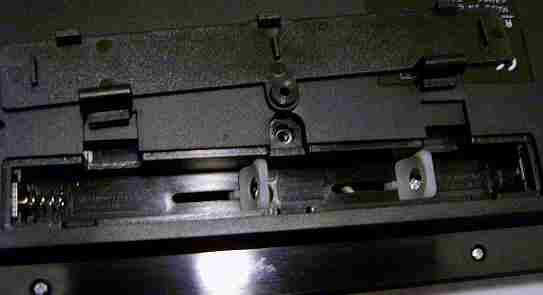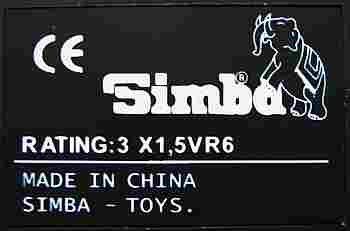| Simba 683 3149 |
|
monophonic
toy keyboard with
POKEY
scale, cheesy squarewave sound & fat lo-fi tekkno rhythm...
|
 |
|
This wonderful little tablehooter sounds absolutely unique because it has not only 2 of the cheesiest multipulse squarewave timbres, but even the corresponding squinting tone scale to emulate the estheticism of the famous Atari POKEY synthesizer chip. Unfortunately it is only monophonic.
Unlike many similar toy keyboards, the keys respond perfectly without annoying delay and also the black keys work like intended. There are 8 preset rhythms made from wonderfully fat sounding low resolution samples with partly unusual tribal tekkno patterns; unfortunately there is no tempo control. But there are 4 drumpad buttons and a "Fill in" mode which genuinely works like "samba" on My Song Maker and thus starts an own rhythm with 4 preset rhythm fill-ins on the drumpads. Rhythm and main voice volume interact in strange ways by analogue distortion - much like when they would be sent together through a pumping audio compressor. There are also 15 cheesy 2 note polyphonic demo melodies played in this lovely detuned POKEY scale.
On the case bottom is a label "SIMBA - TOYS", and on the top the sticker "MY MUSIC WORLD", but no particular model name. Due to Simba released various other "My Music World" toy instruments, I think that the model number "683 3149" is the genuine name of this thing. I bought this specimen in 2004 for 9.99€ in a German Marktkauf shopping center, but they also appear on eBay. I am not sure if it was really made in 2004, since sound and case design rather resemble early 1990th toy keyboards.
By the lack of volume control this instrument yells way to loud in unmodified state; very unusual is that the power amplifier is built into the CPU. (I hope it won't toast over time.) With some circuit bending you can get the most bizarre distorting and howling tekkno noises out of this wonderful tablehooter.
 |
 |
 |
 |
 |
 |
There are only 2 OBS preset sounds with the same simple decay envelope; "piano" is the usual plain squarewave musicbox timbre, "guitar" is the same with a buzzier multipulse timbre. Particularly with empty batteries the sounds howl in a charming way. The special feature of this keyboard is the fairly off and oriental sounding POKEY tone scale, which is unusual for a keyboard with 32 fully working keys since most digital toy keyboards with such an archaic scale have no sharps and only 8 keys or similar. With the "echo" button (stops any rhythm and vice versa) you can add a decaying echo to the main voice and drumpad sounds. It always repeats 5 times; with main voice it has about 2Hz, with drumpad percussion it depends on the sample length, because it directly loops them (the shorter, the faster).
The 8 rhythms are made from really fat lo-fi samples and have partly quite unusual tribal patterns. The samples end with a quiet popping noise, which gives them a lot of pressure. Especially the cowbell(?) resembles more a gamelan, and one sound (clap?) resembles a rough hissing dull POKEY noise (like knocking on a half full matchbox or rice box of cardboard), which gives the rhythms a bizarre exotic touch. Unfortunately there is no tempo control and annoying is that the 8 rhythms can be only selected in sequence by a single button, and they always jump back to the 1st rhythm when rhythm is stopped in any way, which badly limits their use for life play tricks. Rhythm stops e.g. by any drumpad press and also after only about 30 seconds of inactivity by auto power-off.
Strange is that drumpad presses always truncate main voice notes, but
not vice versa. In echo mode here also only the last played sound (main
voice or drumpad) gets the echo. The "Fill in" button rather behaves like
the "samba" mode on My Song Maker;
it starts an own preset rhythm (4 beat, quite fat), and the 4 drumpads
start immediately each a different fill-in pattern, which plays 2 times
and then the 4 beat rhythm continues.
circuit bending detailsThe hardware of this instrument is a simple single- chip construction, but seems to be a completely independent design that has no particular circuit similarities with My Music Center hardware. Very unusual is that the (bipolar) power amplifier is integrated into the CPU (COB without heatsink) and that the DC controllable clock input has an internal stabilization circuit that makes it behave very unusual.
keyboard matrixThe diode- less keyboard matrix uses an odd pattern to save IC pins, thus there are no dedicated input and output lines but they alternatingly change their rolls (similar like with HBATEC). The inputs are active- high and thus react on +Vs.There is a ribbon cable with a row of 13 solder joints those connect the CPU with the control panel.
clock pitch control & shitshotThe CPU has a DC controllable clock frequency that is set by an external 47 kOhm(?) resistor. But unlike the many My Music Center hardware variants, this one behaves very special, because it apparently contains an internal stabilization since it still plays at a remotely correct pitch with resistor removed. Possibly it was initially designed to work without external resistor, but one was added because the frequency was not close enough to the intended value and thus the pitch was too off. Unlike all other CPUs with DC controllable clock, when the voltage is slowly increased, here the frequency does no monotonous ascent or descent, but here first the pitch ascends, then it jumps down again and then ascends to the maximum. With voltage below the turning point, the pitch howls stronger than above it; apparently there is an internal stabilization circuit in the CPU that is inactive with too low voltage.For pitch control connect a 100 kOhm potentiometer with its left end with GND and its right end through a 120 kOhm resistor with +Vs. Connect the wiper through 100 Ohm with the pitch input of the CPU. (Remove the original 47 kOhm resistor). When turned fully up, the CPU will crash and make some shitshot nonsense (main voice turns e.g. into buzzy chirping), but unlike My Music Center stuff, it does never stay crashed but will automatically reset the CPU when turned low enough again (plays intro jingle). At very low clock settings the individual bit stream pulses of the DAC turn audible as bizarre chirping or purring tones. The change between normal sound and bit stream pulses comes very sudden; apparently also here an internal regulator circuit holds against it until it exceeds its value range. sound output & volume controlwarning: The power amplifier is integrated into the CPU and is bipolar, thus the speaker is connected with both leads to it. Do not short any of them with GND or +Vs because this will likely destroy the CPU.Thus an added volume control potentiometer (I used 2.2 kOhm) needs to be connected with its ends between both amplifier outputs (not against GND or +Vs); disconnect one speaker lead from the amp and connect it through a speaker mute switch with the wiper. Also connect a sound output jack with both leads through each a 100nF capacitor the same way like the speaker, but before the speaker mute switch. For details see schematics. clock feedback controlsThe idea behind this control is to feedback the audio signal from the amplifier outputs back into the clock input to produce something like ring modulation. But by the very non- linear nature of this control, the resulting sound effects are much more complex and vary between mild variations of the percussion timbres to the most incredible howling tekkno noise stuff that rather resembles a howling wolf, cat meow or a buzzing chainsaw. (Unfortunately the CPU often resets with startup jingle by too extreme settings, but the jingle can be truncated by playing any note.)For this I added a "tilt" potentiometer with both ends between the amp outputs and its wiper through a capacitor selector circuit and a switch and a disable switch with the right end of the added pitch control potentiometer. For details see schematics. The potentiometer changes timbre and envelope of the effect, while the capacitor value has strong effect on the intensity but also influences the other parameters. The sensitivity of these controls also strongly depends on the actual pitch setting. The red capacitor in the schematics symbolizes a more complex capacitor selector assembly that I have shown above it. It contains a DIP switch block with some internal capacitors, a rotary capacitor (tuning cap from old transistor radio, all its systems wired parallel for maximum effect) and a jack for external capacitors or other signal inputs. I made my jack from a piece of an IC socket to fit different capacitor widths, because depending on the capacitor value, the intensity and envelope duration varies a lot. attention: The 4 overvoltage protection diodes against GND and +Vs are a crucial component to prevent destruction of the CPU. Here they not only protect the CPU against static electricity from touching the capacitor input jack, but particularly protect it from remaining charge in the capacitors, those can potentially exceed the tolerable CPU voltage range (between GND and +Vs) when a charged capacitor is switched off, the tilt pot is turned and then it is switched on again, or especially when a still charged electrolytic cap is manually inserted wrongways into the capacitor jack. The alternating switch (a normal 2 step slide switch) permits to disable the entire capacitor selector assembly to switch between normal and changed sound; at the other end I added a 4.7µF capacitor against GND to reduce the howling with empty batteries. An side effect of this is that now the startup jingle howls when the instrument switches on (also after auto power-off). To disable this behaviour, simply shift the switch into an intermediate position. |
There are 15 (partly short) demo melodies on this instrument. They play all 2 note polyphonic in this lovely squinting POKEY scale; the main voice uses the current preset sound (switchable during demo), the 2nd voice always stays "piano".
The 15 demo melodies are:
| removal of these screws voids warranty... | ||
 |
||
|
|